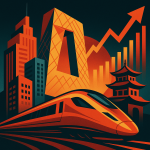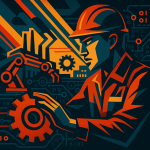Key Points
- China’s Ministry of Industry and Information Technology (MIIT) and seven other departments have released an “Implementation Plan” for the digital transformation of its machinery industry.
- By 2027, the plan aims for over 50% of machinery enterprises to reach “Intelligent Manufacturing Capability Maturity Level 2” or higher, and to establish no fewer than 200 “excellent” smart factories.
- The long-term goal for 2030 is an even deeper transformation, with over 60% of enterprises reaching Maturity Level 2 or higher, and the establishment of no fewer than 500 “excellent” smart factories.
- The initiative emphasizes the deep integration of AI and big data, aiming for full-scale digital transformation, connected supply chains, and a self-sufficient product and service supply system.

China just dropped a massive roadmap for the digital transformation of its machinery industry, and it’s a game-changer.
Eight government departments, led by the powerhouse Ministry of Industry and Information Technology (MIIT), have co-authored a new “Implementation Plan.”
The goal? To supercharge the country’s machinery sector with AI, big data, and smart manufacturing tech.
Let’s break down what this means for investors, founders, and anyone watching the global tech scene.
The 2027 Sprint: Building the Foundation for Smart Manufacturing
The plan sets some seriously ambitious short-term goals to be hit by 2027.
This isn’t just about tinkering; it’s about a fundamental rewiring of the entire industry.
- Widespread Tech Adoption: Digital and intelligent technologies deeply embedded from R&D to after-sales.
- Maturity Level Up: Over 50% of machinery enterprises to reach “Intelligent Manufacturing Capability Maturity Level 2” or higher.
- “Excellent” Smart Factories: No fewer than 200 top-tier, highly efficient smart factories to be created.
- Building an Ecosystem: Cultivate system solution providers combining industry and digital expertise.
- Practical Solutions: Develop at least 200 outstanding, real-world, scenario-based solutions.
Here’s the breakdown:
- Widespread Tech Adoption: Digital and intelligent technologies will be deeply embedded across the board—from R&D and design to manufacturing, management, and even after-sales service.
- Maturity Level Up: Over 50% of machinery enterprises are expected to reach “Intelligent Manufacturing Capability Maturity Level 2” or higher. This means moving beyond isolated automation to more integrated, data-driven processes.
- “Excellent” Smart Factories: The plan calls for the creation of no fewer than 200 top-tier, highly efficient smart factories. Think of these as the blueprints for the future of Chinese manufacturing.
- Building an Ecosystem: The government will actively cultivate a new class of system solution providers who get both the industry’s grit and the digital world’s code.
- Practical Solutions: Development of at least 200 outstanding, real-world, scenario-based solutions to solve specific industry problems and boost service capabilities.

Resume Captain
Your AI Career Toolkit:
- AI Resume Optimization
- Custom Cover Letters
- LinkedIn Profile Boost
- Interview Question Prep
- Salary Negotiation Agent

The 2030 Marathon: Aiming for AI-Powered Dominance
If the 2027 goals are about building the foundation, the 2030 vision is about building the skyscraper.
This is where China doubles down and aims for true global leadership in advanced manufacturing.
- Full-Scale Transformation: Vast majority of large-scale machinery enterprises to complete at least one full cycle of digital transformation.
- Connected Supply Chains: Key players achieve data interconnectivity and collaborative sharing.
- AI Integration: Leading companies to deeply integrate Artificial Intelligence (AI) into core operations.
- Hitting Critical Mass: Over 60% of enterprises to reach Intelligent Manufacturing Capability Maturity Level 2 or higher.
- 500+ Smart Factories: No fewer than 500 “excellent” smart factories established nationwide.
- Self-Sufficiency: Build a “comprehensive, secure, and controllable” product and service supply system.
The targets get even bigger:
- Full-Scale Transformation: The vast majority of large-scale machinery enterprises will have completed at least one full cycle of digital transformation.
- Connected Supply Chains: Key players across the supply chain—from raw materials to finished products—will achieve data interconnectivity and collaborative sharing. This is a massive move towards a more resilient and efficient industrial network.
- AI Integration: Leading companies will be expected to deeply integrate Artificial Intelligence (AI) into their core operations. This is the leap from “automated” to “intelligent.”
- Hitting Critical Mass: The maturity target is bumped up, with over 60% of enterprises reaching Intelligent Manufacturing Capability Maturity Level 2 or higher.
- 500+ Smart Factories: The number of “excellent” smart factories will more than double, with a new target of no fewer than 500 established across the country.
- Self-Sufficiency: A key long-term goal is to build a “comprehensive, secure, and controllable” product and service supply system, reducing reliance on foreign technology and enhancing national economic security.

Why This Matters for You (And the World)
This isn’t just another government policy paper. It’s a clear signal of intent.
For investors, this plan highlights where government support and, consequently, massive capital will flow. Companies involved in industrial software, IoT, robotics, and enterprise AI in China are positioned for huge growth.
For founders and tech companies, this creates an enormous market for new solutions. There’s a clear demand for vendors who can help traditional machinery companies make the digital leap, especially those with expertise in both hardware and software.
For global competitors, this signals a major shift. China is aggressively moving up the value chain from the “world’s factory” to the “world’s smart factory.” This will have profound implications for global supply chains, competition, and innovation.
This comprehensive initiative shows China’s unwavering commitment to solidifying its manufacturing prowess through deep, intelligent upgrades, ultimately preparing its economy for the next era of industrial competition.
The scale and ambition of this plan for the digital transformation of the machinery industry cannot be overstated.

Find Top Talent on China's Leading Networks
- Post Across China's Job Sites from $299 / role, or
- Hire Our Recruiting Pros from $799 / role
- Qualified Candidate Bundles
- Lower Hiring Costs by 80%+
- Expert Team Since 2014
Your First Job Post


![China’s A-Share Giants Rake It In- Banks Top ¥2 Trillion RMB Annually, ICBC Nears ¥1 Billion RMB Profit Daily [FreshFromChina]](https://freshfromchina.com/wp-content/uploads/2025/05/Chinas-A-Share-Giants-Rake-It-In-Banks-Top-¥2-Trillion-RMB-Annually-ICBC-Nears-¥1-Billion-RMB-Profit-Daily-FreshFromChina-150x150.png)


